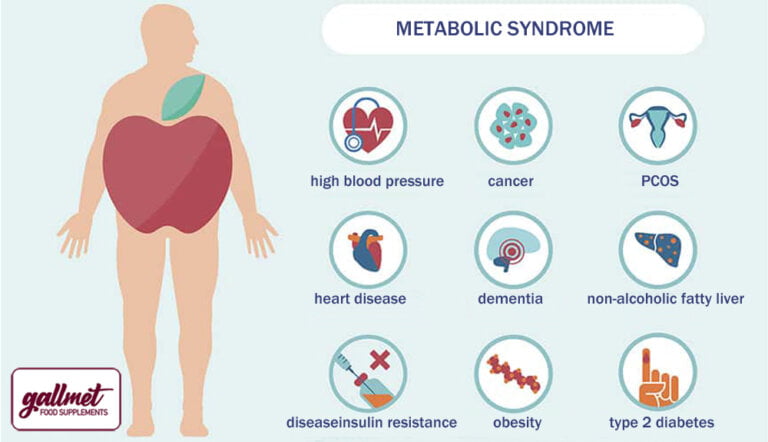Association between metabolic syndrome and homocysteine levels

What are the symptoms of metabolic syndrome?
- High blood pressure,
- belly appearing apple-type obesity,
- diabetes or prediabetes (a disorder of carbohydrate metabolism),
- lab abnormalities: elevated triglyceride (blood fat) levels, elevated LDL “bad cholesterol” levels and reduced HDL “good cholesterol” levels, and elevated homocysteine levels
In metabolic syndrome, the blood homocysteine level is significantly high, which leads to a higher incidence of diseases affecting blood vessels. Homocysteine levels are directly related to age, waist circumference, fasting blood glucose, blood fat and uric acid levels.1, 2 If you have already developed one of the symptoms of metabolic syndrome, it is likely that other symptoms will also develop over time. People who already have the three symptoms of metabolic syndrome are much more likely to have a stroke or heart attack or any other heart disease.
What can I do if I already have one of these symptoms?
The elements of the metabolic syndrome need to be treated together, and lifestyle changes are of great importance:
- daily physical activity,
- reduced consumption of sugar, carbohydrates and alcohol,
- not smoking,
- eating a dietary supplement that helps relieve all symptoms and prevent more serious conditions.
GALLMET Heart Plus capsules contain folate (vitamin B9), betaine, vitamins B6 and B12, which contribute to the body's proper homocysteine levels!💊
People with high homocysteine levels have higher blood levels of uric acid and lower levels of folate (vitamin B9) and vitamin B12 than healthy people. Vitamin B9 (folate) and vitamin B12 may be useful for high uric acid and homocysteine levels in vascular disorders such as kidney damage.5
Folate reduces uric acid levels to a greater extent the higher the homocysteine level. 6 The folate intake of people in central Europe is also very low at only about a third of the level recommended in dietary recommendations.7 In addition to this, many of the foods that are forbidden or avoided in the gout diet are also the main source of vitamin B12, so vitamin B12 deficiency can be exacerbated.
It should be noted that many products containing vitamin B9 contain folic acid, while the bioavailability of folic acid is not the same as natural folate in patients with common gene defects – MTHFR 1298C and C677T. Folic acid does not directly reduce homocysteine levels but can cause kidney damage and, unlike natural folate, does not cross the blood-brain barrier!8
What ingredients are effective against the symptoms of metabolic syndrome?
In addition, chromium is a trace element that helps regulate blood glucose levels in glucose intolerance, type 2 diabetes and gestational diabetes, and may alleviate diabetic neuropathy. Supplemental chromium 200 µg/day is sufficient for people with mild glucose intolerance, but diabetics usually need more than 200 µg/day, as do women with gestational diabetes.3, 4
The active substances in Terminalia chebula extract have significant beneficial effects on blood glucose levels.5 Damage to the endothelium, the squamous epithelium covering the inner surface of blood vessels, is one of the most important complications of type 2 diabetes and is associated with the risk of cardiovascular disease. Terminalia chebula extract may significantly improve endothelial function, reduce oxidative stress and CRP inflammation marker levels in the blood, regulate HbA1c levels, and minimize the risk of cardiovascular disease and high blood glucose.6
Vitamin B9 (folate) is of paramount importance in reducing the adverse effects of homocysteine levels and improving endothelial function, but vitamins B12 and B6 also play a role in maintaining normal homocysteine levels.
With vitamins B9 (folate), B12 and B6, the occurrence of vascular diseases associated with high homocysteine levels can be avoided:
- in 20% of coronary artery diseases,
- in 40% of cerebrovascular disease,
- in 60% of diseases of the endothelial vessels.
With the use of these three vitamins, the risk of vascular disease can be reduced by 62% and the number of cases by 2/3!7
[1] Elevated Homocysteine Levels Are Associated With the Metabolic Syndrome and Cardiovascular Events in Hypertensive Patients - Cristiana Catena, Gianluca Colussi, Francesca Nait, Frine Capobianco and Leonardo A. Sechi https://academic.oup.com/ajh/article/28/7/943/2743393
[2] Metabolic complications of obesity in adolescents, with special reference to the occurrence of elevated uric acid levels - Dr László Ságodi, Dr Viktória Fehér, Dr Emőke Kiss-Tóth, Dr Andrea Almási and Dr László Barkai https://core.ac.uk/reader/42947800
[3] Chromium, Glucose Intolerance and Diabetes - Richard A. Anderson PhD https://paulogentil.com/pdf/Chromium%2C%20Glucose%20Intolerance%20and%20Diabetes.pdf
[4] Elevated Intakes of Supplemental Chromium Improve Glucose and Insulin Variables in Individuals With Type 2 Diabetes - Richard A. Anderson, Nanzheng Cheng, Noella A. Bryden, Marilyn M. Polansky, Nanping Cheng, Jiaming Chi and Jinguang Feng https://diabetesjournals.org/diabetes/article/46/11/1786/10196/Elevated-Intakes-of-Supplemental-Chromium-Improve
[5] A Review on Potential Mechanisms of Terminalia chebula in Alzheimer's Disease - Amir R. Afshari, Hamid R. Sadeghnia and Hamid Mollazadeh https://www.ncbi.nlm.nih.gov/pmc/articles/PMC4749770/
[6] Effect of an aqueous extract of Terminalia chebula on endothelial dysfunction, systemic inflammation, and lipid profile in type 2 diabetes mellitus: A randomized double-blind, placebo-controlled clinical study - Usharani Pingali, Deepasree Sukumaran, Chandrasekhar Nutalapati https://onlinelibrary.wiley.com/doi/10.1002/ptr.6771
[7] Homocysteine - a risk factor for atherosclerosis - Dr. László Debreceni - Medical Weekly_2001.07.01. issue 27. http://real-j.mtak.hu/11264/



